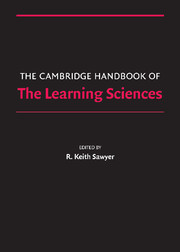Book contents
- Frontmatter
- Contents
- Preface
- Contributors
- 1 Introduction
- PART I FOUNDATIONS
- PART II METHODOLOGIES
- PART III THE NATURE OF KNOWLEDGE
- 14 Case-Based Reasoning
- 15 The Knowledge Integration Perspective on Learning and Instruction
- 16 A History of Conceptual Change Research
- 17 Spatial Representations and Imagery in Learning
- 18 Literacy and the Learning Sciences
- PART IV MAKING KNOWLEDGE VISIBLE
- PART V LEARNING TOGETHER
- PART VI LEARNING ENVIRONMENTS
- Afterword: After How Comes What
- Epilogue: The Fundamental Issue in the Learning Sciences
- Author Index
- Subject Index
- References
15 - The Knowledge Integration Perspective on Learning and Instruction
Published online by Cambridge University Press: 05 June 2012
- Frontmatter
- Contents
- Preface
- Contributors
- 1 Introduction
- PART I FOUNDATIONS
- PART II METHODOLOGIES
- PART III THE NATURE OF KNOWLEDGE
- 14 Case-Based Reasoning
- 15 The Knowledge Integration Perspective on Learning and Instruction
- 16 A History of Conceptual Change Research
- 17 Spatial Representations and Imagery in Learning
- 18 Literacy and the Learning Sciences
- PART IV MAKING KNOWLEDGE VISIBLE
- PART V LEARNING TOGETHER
- PART VI LEARNING ENVIRONMENTS
- Afterword: After How Comes What
- Epilogue: The Fundamental Issue in the Learning Sciences
- Author Index
- Subject Index
- References
Summary
The knowledge integration perspective emerged from studies of the conceptions of scientific phenomena that students bring to science class, from design studies refining science instruction, and from longitudinal studies of students' learning over weeks, months, and years. These studies stress that learners grapple with multiple, conflicting, and often confusing, ideas about scientific phenomena. They characterize learners as developing a repertoire of ideas, adding new ideas from instruction, experience, or social interactions, sorting out these ideas in varied contexts, making connections among ideas at multiple levels of analysis, developing more and more nuanced criteria for evaluating ideas, and formulating an increasingly linked set of views about any phenomenon.
The knowledge integration perspective capitalizes on the varied ideas held by students both individually and collectively to stimulate science learning. The knowledge integration perspective synthesizes recent investigations of science learning and instruction, culminating in a set of design patterns that promote coherent and cohesive understanding, and design principles that guide customization of patterns. This chapter describes the process of knowledge integration and how knowledge integration resonates with current research programs. It offers guidance to researchers and curriculum designers wishing to promote lifelong science learning.
Learning and Knowledge Integration
My colleagues and I conducted over forty case studies of middle school students who were studying thermodynamics (Clark & Linn, 2003; Linn & Hsi, 2000). These studies illustrate the typical process of knowledge integration. We found that students generate a repertoire of ideas about each concept they are learning and about the links between concepts.
- Type
- Chapter
- Information
- The Cambridge Handbook of the Learning Sciences , pp. 243 - 264Publisher: Cambridge University PressPrint publication year: 2005
References
- 36
- Cited by



